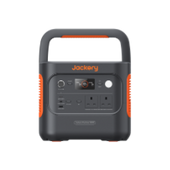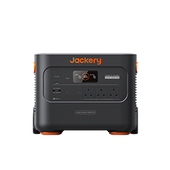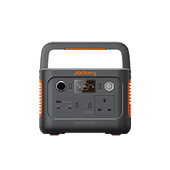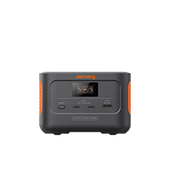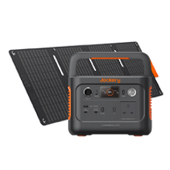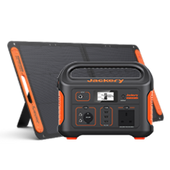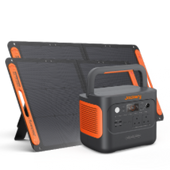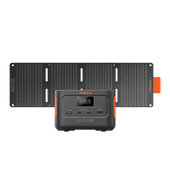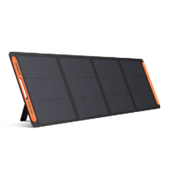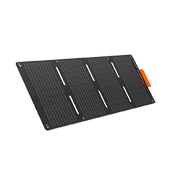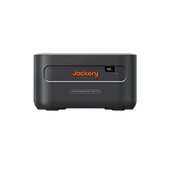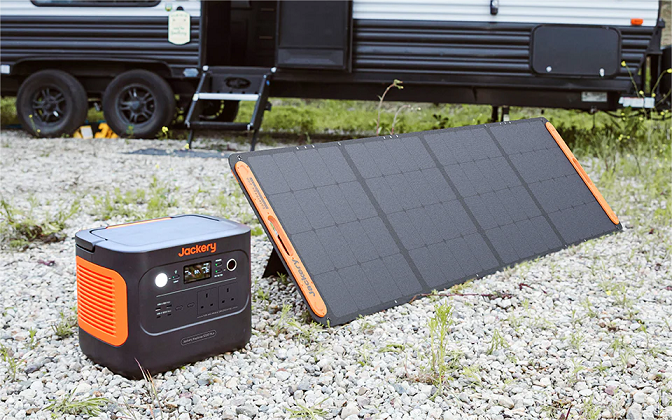Most batteries in a power station or solar generator are classified based on voltages. Whether a 12V car battery or a 24V deep cycle battery, the term "battery voltage" is relatively common. The battery voltage chart represents the relation between voltage and the battery's state of charge.
Jackery Explorer Power Stationsare designed with high Ah and Wh ratings. They are equipped with lithium-ion batteries, capable of storing and supplying power to most electrical devices. With a power capacity of 2160Wh, the Jackery Explorer 2000 Pro can seamlessly power 96% of home or outdoor appliances.
 | |
- Features 2160Wh battery capacity to power up to 96% of outdoor appliances. - Equipped with a pull rod and double wheels for portability. - Functional in temperatures up to -20°C /-4°F - Smart app control to check the power station’s status. - Fully upgraded BMS for all-around safety. |
What Is Battery Voltage Chart
The term "battery voltage" represents the electrical potential difference between any battery's positive and negative terminals. The battery voltage is crucial because it determines the power or energy your battery can supply, its charge state, and the voltage required for certain electronics.
Battery voltage charts describe the relation between the battery's charge state and the voltage at which the battery runs. These battery charging voltages can range from 2.15V per cell to 2.35V per cell, depending on the battery type. You can check or read a battery's voltage using a multimeter.
Percentage of Charge | 12V Battery Voltage | Specific Gravity using Hydrometer |
100% | 12.70 | 1.265 |
95% | 12.64 | 1.257 |
90% | 12.58 | 1.249 |
85% | 12.52 | 1.241 |
80% | 12.46 | 1.233 |
75% | 12.40 | 1.225 |
70% | 12.36 | 1.218 |
65% | 12.28 | 1.204 |
55% | 12.24 | 1.197 |
50% | 12.20 | 1.190 |
45% | 12.16 | 1.183 |
40% | 12.12 | 1.176 |
35% | 12.08 | 1.169 |
30% | 12.04 | 1.162 |
25% | 12.00 | 1.155 |
20% | 11.98 | 1.148 |
15% | 11.96 | 1.141 |
10% | 11.94 | 1.134 |
5% | 11.92 | 1.127 |
0% (Discharged) | 11.90 | 1.120 |
The Type of Batteries
The battery voltage chart differs depending on the type of battery. Below we'll reveal five different types of batteries.
Lead-Acid: These battery types are economical and extremely popular choices. The heavy and bulkier batteries sometimes leak, making the device unusable.
Lithium-ion: These commonly used battery types have a superior energy density and can store more energy than others. These lightweight batteries are designed for portable devices.
Deep Cycle: A deep-cycle battery is designed to be regularly deeply discharged using its maximum capacity. It has thicker active plates, thicker separators, and higher-density active paste material.
LiFePO4: Also known as lithium iron phosphate or LFP battery, it offers increased power output, reduced weight, longer lifetime, and faster recharging.
AGM: AGM (Absorbent Glass Mat) is an advanced lead-acid battery type. The battery contains positive and negative lead and lead oxide plates that release electrons.
What Is State of Charge and Discharge Chart
State of charge (SoC), usually represented in percentage, is the charge level of an electric battery relative to its capacity. Battery's SoC can be quickly determined by reading either specific electrolyte gravity or terminal voltage.
State of Charge | Sealed or Flooded Lead Acid battery voltage | Gel battery voltage | AGM battery voltage |
100% | 12.70+ | 12.85+ | 12.80+ |
75% | 12.40 | 12.65 | 12.60 |
50% | 12.20 | 12.35 | 12.30 |
25% | 12.00 | 12.00 | 12.00 |
0% | 11.80 | 11.80 | 11.80 |
A battery's depth of discharge (DoD) indicates the percentage of discharged battery relative to overall battery capacity. The depth of discharge (DoD) complements the state of charge (SoC). That means if DoD increases, SoC decreases.
Battery or Battery Pack Ah Rating | 30-Minute Maximum Discharge Current |
5Ah | 10A |
7Ah | 14A |
8Ah | 16A |
9Ah | 18A |
10Ah | 21A |
12Ah | 24A |
14Ah | 31A |
15Ah | 32A |
18Ah | 40A |
22Ah | 46A |
35Ah | 84A |
Battery Voltage Charts
The battery voltage charts track the battery's voltage and maintain the battery. The primary role of voltage monitoring is to extend the battery's lifespan.
Lead-Acid Battery Voltage Chart
Lead-acid battery voltage varies depending on the temperature, discharge rate, and battery type (sealed or flooded).
Flooded lead-acid batteries are cheaper but require proper ventilation and more maintenance. Alternatively, sealed lead-acid batteries need less maintenance and ventilation.
Lead-Acid Battery Voltage Chart
Capacity | 6V Sealed Lead Acid Battery | 6V Flooded Lead Acid Battery |
100% | 6.44V | 6.32V |
90% | 6.39V | 6.26V |
80% | 6.33V | 6.20V |
70% | 6.26V | 6.15V |
60% | 6.20V | 6.09V |
50% | 6.11V | 6.03V |
40% | 6.05V | 5.98V |
30% | 5.98V | 5.94V |
20% | 5.90V | 5.88V |
10% | 5.85V | 5.82V |
0% | 5.81V | 5.79V |
Lithium-ion Battery Voltage Chart
Lithium-ion batteries are most used in power stations and solar systems, all thanks to the built-in additional layer of security. The popular voltage sizes of lithium-ion batteries include 12V, 24V, and 48V. Let's understand the discharge rate of a 1-cell lithium battery at different voltages.
Lithium-ion Battery Voltage Chart:
Capacity (%) | 1 Cell | 12 Volt | 24 Volt | 48 Volt |
100 | 3.40 | 13.6 | 27.2 | 54.4 |
90 | 3.35 | 13.4 | 26.8 | 53.6 |
80 | 3.32 | 13.3 | 26.6 | 53.1 |
70 | 3.30 | 13.2 | 26.4 | 52.8 |
60 | 3.27 | 13.1 | 26.1 | 52.3 |
50 | 3.26 | 13.0 | 26.0 | 52.2 |
40 | 3.25 | 13.0 | 26.0 | 52.0 |
30 | 3.22 | 12.9 | 25.8 | 52.5 |
20 | 3.20 | 12.8 | 25.6 | 51.2 |
10 | 3.00 | 12.0 | 24.0 | 48.0 |
0 | 2.50 | 10.0 | 20.0 | 40.0 |
LiFePO4 Battery Voltage Chart
LiFePO4 battery voltage charts reveal the SoC (state of charge) based on different voltages, such as 12V, 24V, and 48V.
LiFePO4 Battery Voltage Chart:
Capacity | 12V | 24V | 48V |
100% (charging) | 14.6V | 29.2V | 58.4V |
100% (resting) | 13.6V | 27.2V | 54.4V |
99% | 13.4V | 26.8V | 53.6V |
90% | 13.3V | 26.6V | 53.2V |
70% | 13.2V | 26.4V | 52.8V |
40% | 13.1V | 26.2V | 52.4V |
30% | 13.0V | 26.0V | 52.0V |
20% | 12.9V | 25.8V | 51.6V |
17% | 12.8V | 25.6V | 51.2V |
14% | 12.5V | 25.0V | 50.0V |
9% | 12.0V | 24.0V | 48.0V |
0% | 10.0V | 20.0V | 40.0V |
Deep Cycle Battery Voltage Chart
Deep cycle batteries are among the most used batteries that discharge slowly to a low SoC and recharge again. Here are the deep cycle battery charts for 12V, 24V, and 48V.
Deep Cycle Battery Voltage Chart:
Capacity | 12V | 24V | 48V |
100% (charging) | 13.00V | 26.00V | 52.00V |
99% | 12.80V | 25.75V | 51.45V |
90% | 12.75V | 25.55V | 51.10V |
80% | 12.50V | 25.00V | 50.00V |
70% | 12.30V | 24.60V | 49.20V |
60% | 12.15V | 24.30V | 48.60V |
50% | 12.05V | 24.10V | 48.20V |
40% | 11.95V | 23.90V | 47.80V |
30% | 11.81V | 23.62V | 47.24V |
20% | 11.66V | 23.32V | 46.64V |
10% | 11.51V | 23.02V | 46.04V |
0% | 10.50V | 21.00V | 42.00V |
AGM Battery Voltage Chart
An AGM battery voltage chart describes the relationship between the state of charge, current, and voltage. Let's see how different charging or discharging currents affect battery voltages.
AGM Battery Voltage Chart:
Capacity | 12V | 24V | 48V |
100% (charging) | 13.00V | 26.00V | 52.00V |
100% (resting) | 12.85V | 25.85V | 51.70V |
99% | 12.80V | 25.75V | 51.45V |
90% | 12.75V | 25.55V | 51.10V |
80% | 12.50V | 25.00V | 50.00V |
70% | 12.30V | 24.60V | 49.20V |
60% | 12.15V | 24.30V | 48.60V |
50% | 12.05V | 24.10V | 48.20V |
40% | 11.95V | 23.90V | 47.80V |
30% | 11.81V | 23.62V | 47.24V |
20% | 11.66V | 23.32V | 46.64V |
10% | 11.51V | 23.02V | 46.04V |
0% | 10.50V | 21.00V | 42.00V |
Jackery Portable Power Stations Explained
Jackery is the leading manufacturer of portable power stations and solar solutions. These battery backups for homes or outdoors are designed to provide reliable power to various applications, including emergency power, camping, RVing, etc.
Jackery portable power stations use lithium-ion batteries, best known for their high efficiency and long lifespan. However, the Jackery Explorer 2000 Plus is equipped with a LiFePO4 battery. Some popular charging solutions offered by Jackery include:
Jackery Explorer 500 Power Station
Jackery Explorer 500 features a high-quality lithium-ion battery with a high capacity of 518Wh. It is extremely easy to carry and features multiple AC outlets, carports, and USB-A ports to charge low-to-high power-consuming appliances. You can recharge the power station using car outlets, solar panels, or electric generators.











The Jackery Explorer 500 is a 518Wh lithium portable power station. It is one of the lightest and most portable rechargeable lithium battery generators on the market.
- Large Capacity: The Jackery Explorer 500 has a 518 watt-hour (24Ah, 21.6V) lithium-ion battery pack and a pure sine wave inverter. It features 1* AC outlet (110V 500W 1000W peak), 3*USB-A ports, 2* DC ports, and 1*car port to run low to high power appliances, including a mini-fridge, air pump, and TV.
- Designed for Portability: The Jackery Explorer 500 portable power station is about the size of a basketball and has a solid handle. Its easy-carry and compact design make the Jackery Explorer 500 perfect for enjoying RV camping and road trips.
- Four Ways to Recharge: The Explorer 500 has a high-quality built-in MPPT charge controller. This allows quick and easy green solar recharging when paired with the Jackery SolarSaga 100W solar panel (sold separately). You can also recharge the Explorer 500 with a wall outlet, car outlet, and electric generator.
Customer Review
"This product is awesome. I cannot recommend it enough. Just got through the power outages in Texas, and the Jackery500 came in so clutch. We were able to power some heating pads, our cell phones, and LED lights for 3 days so that our house was lit, and we stayed (sort of) warm." — Nick Athey.

The portable power station has a capacity of 1002Wh and 1000W (2000W peak) output. The lithium-ion battery can be quickly recharged using the AC outlet in 1.8 hours. You can efficiently charge 93% of home or outdoor appliances during emergency backup and RV trips.
Customer Review
"The Jackery Explorer 1000 Pro with 2*80w Solarsaga panels is a great power station for camping and use as an emergency source of household power. It will power most small appliances and charge to a full charge in under 8 hours with 2*80w SolarSaga panels." — Tim.

Equipped with a LiFePO4 battery, the Jackery Explorer 2000 Plus can easily expand from 2kWh to 12kWh. It can power heavy-duty devices up to 6000 watts. The power station has advanced IBC technology and ultra-fast solar charging in only 2 hours.





- Expandable for Versatile Scenarios: 2-12 kWh of expandable capacity
- Leaping Performance: Powers Heavy-duty Devices up to 3000W
- Ultra Fast Solar Charging: Advanced IBC Technology, Fast Solar Charge in 2 Hours
- Long-lasting Reliability: Outstanding LiFePO4 Battery with 10-Year Lifespan
- ChargeShield Technology: Using a unique variable-speed charging algorithm, fast charge technology boosts battery life by 50%
- Guaranteed Satisfaction: Excellent 5-Year Long Warranty

Power Station | Capacity | Recharging Time | Ports | Appliances |
Explorer 500 | Lithium-ion 24Ah/21.6V (518.4Wh) | AC Adapter: 7.5H Car Adapter (12V): 7.5H 1 x SolarSaga 100W Solar Panel: 9.5H | AC Output (x1): 110V, 60Hz, 500W (1000W Peak) DC Output (x2): 12V⎓7A USB-A Output (x3): 5V⎓2.4A Car Port (x1): 12V⎓10A AC Input: doesn't support direct AC charging - use external AC charger provided DC Input: 24V⎓3.75A | Light (5W): 88H CPAP (28W): 15H Electric blanket (55W): 8H Blender (300W): 1.4H Space Heater (350W): 1.2H
|
Explorer 1000 Pro
| Lithium-ion 46.4Ah/21.6V (1002Wh) | AC Adapter: 1.8H Car Adapter (12V): 5.44H 4 x SolarSaga 200W Solar Panel: 1.8H 2 x SolarSaga 80W Solar Panel: 9H | AC Output (x3): 120V, 60Hz, 1000W (2000W Peak) USB-A Output (x2): Quick Charge 3.0x2, 18W Max USB-C Output (x2): 100W Max, (5V, 9V, 12V, 15V, 20V up to 5A) Car Port (x1): 12V⎓10A AC Input: 120V, 60Hz, 15A Max DC Input: 12V-17.5V⎓8A Max, Double to 16A Max 17.5V-60V⎓11A, Double to 22A/800W Max | Blender (300W): 2.8H Space Heater (350W): 2.4H Microwave (700W): 1.2H Kettle (850W): 1H |
Explorer 2000 Plus | LiFePO4 45.6Ah/ 44.8V DC (2042.8Wh) | AC Adapter: 2H Car Adapter (12V): 25H 6 × SolarSaga 200W: 2H 4 × SolarSaga 200W: 3.8H 3 × SolarSaga 200W: 4.8H 2 × SolarSaga 200W: 7H 1 × SolarSaga 200W: 14H | AC Output (×4) 120V~ 60Hz, 20A Max AC Output (×1) 120V~ 60Hz, 25A Max USB-A Output (x2): Quick Charge 3.0, 18W Max USB-C Output (x2): 100W Max, (5V, 9V, 12V, 15V, 20V up to 5A) Car Port (x1): 12V⎓10A AC Input: 120V, 60Hz, 15A Max DC Input: 11V-17.5V, 8A Max, Double to 8A Max 17.5V-60V, 12A Max, Double to 24A/1400W Max | Blender (300W): 5.7H Space Heater (350W): 4.9H Microwave (700W): 2.4H Kettle (850W): 2H |
Battery Voltage Chart FAQs
What voltage is considered a bad battery?
When the battery voltage drops to 12.2V, it is considered a bad battery. That means the battery is no longer capable of holding a charge. In such a case, you'll need to replace the battery with a new one.
What voltage is a 12V battery at 50%?
At 50% state of charge, a 12V battery has a voltage of 12.20. The below table reveals the voltage at different percentages of charge of a 12V battery voltage.
Percentage of Charge | 12V Battery Voltage | Specific Gravity |
100 | 12.70 | 1.265 |
95 | 12.64 | 1.257 |
90 | 12.58 | 1.249 |
85 | 12.52 | 1.241 |
80 | 12.46 | 1.233 |
75 | 12.40 | 1.225 |
70 | 12.36 | 1.218 |
65 | 12.32 | 1.211 |
60 | 12.28 | 1.204 |
55 | 12.24 | 1.197 |
50 | 12.20 | 1.190 |
45 | 12.16 | 1.183 |
40 | 12.12 | 1.176 |
35 | 12.08 | 1.169 |
30 | 12.04 | 1.162 |
25 | 12.00 | 1.155 |
20 | 11.98 | 1.148 |
15 | 11.96 | 1.141 |
10 | 11.94 | 1.134 |
5 | 11.92 | 1.127 |
Discharged | 11.90 | 1.120 |
How to choose a new battery?
When selecting a new battery, check its Ah (amp-hour) rating. The physical size and terminal type are other crucial factors to remember. The popular types of batteries include lithium-ion and LiFePO4. They generally have a longer lifespan and can hold a charge for more time.
Final Thoughts
Battery voltage is an important term that lets you expand its lifespan. The battery voltage chart will help you identify the proper voltage for careful charging and discharging. As a result, this positively impacts the battery life and ensures the power station is powerful and long-lasting.
Jackery Explorer Power Stations are robust and powerful charging solutions for home or outdoor usage. You can charge these power stations by connecting them with Jackery SolarSaga Solar Panels. Once fully charged, they can supply power to most appliances for longer hours.

